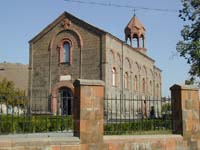|
 |
|
 |
| |
OSHAKAN |
|
 |
|
 |
| |
Êàòåãîðèÿ: Itineraries |
Íîâîñòü îò: admin | 15.03.2007, 05:30

OSHAKAN - a small settlement situated not far from Yerevan. The first mention about Oshakan goes back to the first half of the IV century. Historians describe the battle between Persians and Armenians (which Armenians won), taken place in this settlement in 336.
However , monuments of earlier period were found in this territory.
On the hill of DIDI the remnants of urartu fortresses of VII-V centuries B.C. were found out. The fortress was constructed of large stones which have been cemented with lime. In the territory of the fortress there were many inhabited and auxiliary constructions. From five palace complexes were excavated only one entirely and a part of the second one. 40 rooms of a palace and a hall were excavated. In the territory of the complex the remnants of church were found out. Archeologists found many paraphernalia of ceramic , stone and bone, more than 100 statuettes. Here were found out burial places from III century B.C. . At excavation many tools, weapons, golden, silver and bronze ornaments were discovered. The current excavations show traces of the masonry of later period of the IV century A.D. on the walls of palaces . Hence we can gather that over centuries the palaces were completed and repopulated.
On the bank of the river Kasagh some necropolises were revealed, laid of large stones. Around them many cross-stone-shaped gravestones- were preserved.
In the settlement the church CION is situated (MANKANOTS), constructed in the VII century. It is a dome temple with four niches, having the cruciform shape. Beside there is a cemetery where many unique gravestones of VI-VII centuries are preserved.
On the suburb of village Oshakan there is the Church of St. MESROP MASHTOTS. Here in the underground crypt rest the relics of the founder of the national alphabet and writing- Mesrop Mashtots. Having received good education, he engaged in educational activity. Over these years he got convinced that education, creation of own writing would help to consolidate people. In fact Armenians did not have their own alphabet. They used foreign letters, adapting them for expression of sounds of the native language, and they did not suffice to transfer of all syllables of the Armenian language. After laborious work he, having defined missing signs of sounds, in 404-405, traced images of letters, arranged them in order and made the textbook for reading. To test the invention, he translated the Bible. This translation nowadays is considered an unsurpassed sample of translational art. Then, within 35 years he indefatigably translated, wrote, and organized national schools at monasteries within the country which further became the centers of national culture. He died in 440 and was buried in Oshakan. Above his tomb the small chapel was erected which stood over 14 centuries. In 1827 on its place a new church was built. Construction has the form of a round dome church. Above the altar part belfry was built and from the right side of the altar there is a crypt where in the base of an ancient chapel under a marble gravestone the relics of Mesrop Mashtots are resting.
In remembrance of 1600 anniversary of Mesrop Mashtots birth in1962 at entry into Oshakan was established a monument , which represented two huge sheets of the open book on which the Armenian alphabet was traced. The five-span stone bridge constructed in 1706 is preserved in Oshakan.
|
|
 |
|
 |

|
 |
|
| |
Ñ÷¸ò÷èê |
 |
|
| |
| Ïí: |
273 |
| Âò: |
375 |
| Ñð: |
165 |
| ×ò: |
161 |
| Ïò: |
234 |
| Ñá: |
233 |
| Âñ: |
391 |
| Âñåãî: |
639057 |
| Ðåêîðä: |
1604 |
| OnLine: |
4 |
|
 |
|
|

